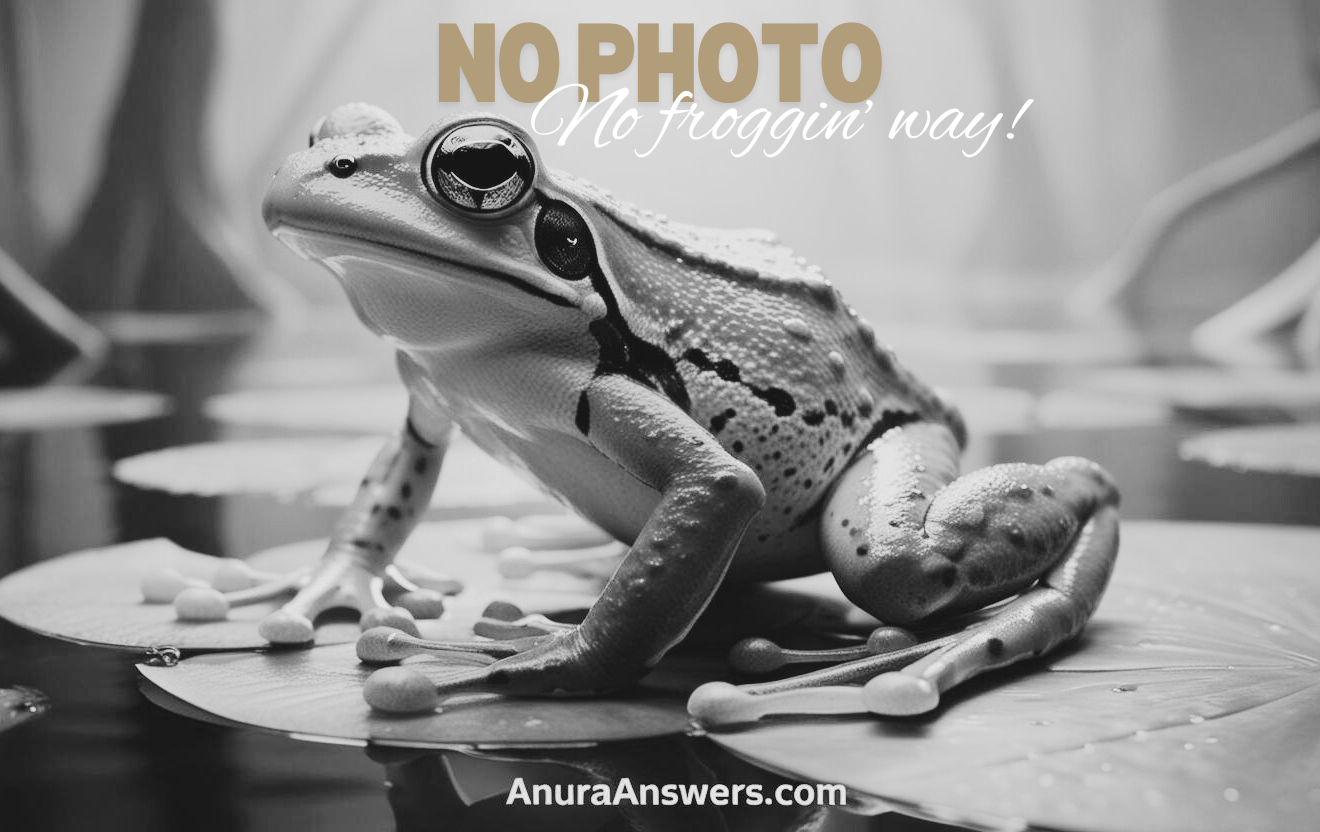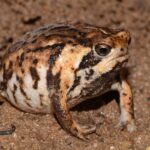- Atelopus chrysocorallus: The Golden Jewel of Central America's Forests
Atelopus chrysocorallus: The Golden Jewel of Central America’s Forests#
Hidden deep within the lush tropical forests of Central America, thriving amidst mist-shrouded trees and crystalline mountain streams, lives a diminutive yet brilliantly adorned creature: Atelopus chrysocorallus. Often known by its common name “Harlequin Toad,” this dazzling amphibian not only captivates scientists and nature enthusiasts alike, but also serves as a beacon for ecosystem health, reflecting the complex web of life flourishing beneath the rainforest canopy.
With a mesmerizing blend of gold, coral, and deep black patterns weaving across its slender frame, Atelopus chrysocorallus embodies the beauty and fragility of tropical biodiversity. Like many of its close relatives within the Atelopus genus, the rich coloration warns potential predators of its toxic defenses, a vivid survival strategy obtained through millions of years of adaptation. Yet despite its remarkable biological adaptations, Atelopus chrysocorallus stands at the brink—caught amid the relentless pressures of habitat destruction, climate change, and disease. Its story offers poignant lessons about both the resilience and vulnerability of Earth’s incredible amphibian diversity.
Taxonomy and Classification#
Belonging to the taxonomic family Bufonidae—the “true toads”—the species Atelopus chrysocorallus finds its place within the fascinating genus Atelopus, widely renowned for its brightly colored “Harlequin toads.” This genus encompasses over a hundred recognized species, though tragically, many are critically endangered or already extinct.
The formal classification of Atelopus chrysocorallus was first described scientifically in 1996, underscoring how recent scientific exploration continues uncovering new gems within Earth’s biodiversity. The name “chrysocorallus” itself provides clues to the animal’s stunning appearance, derived from Greek and Latin roots meaning “gold” and “coral,” easily painting a picture of its exquisite coloration.
Closely related species such as Atelopus zeteki—the Panamanian golden frog—and Atelopus varius share similar brilliant hues and toxic traits, all evolved to avoid predation. These close relatives serve as potent reminders of the urgent conservation attention needed across the genus.
Natural Habitat#
Geographic Range and Distribution#
Atelopus chrysocorallus is endemic to a relatively restricted geographic region of Central America, primarily found within specific locales of Panama and Costa Rica. Its range centers around pristine montane rainforest ecosystems, typically occurring at elevations ranging from about 600 to 1500 meters above sea level. This elevation band offers an ideal combination of moisture, temperature, and habitat complexity, crucial for its lifestyle.
Habitat Preferences#
Preferring to dwell alongside fast-flowing, crystal-clear streams shaded beneath humid, dense canopies, Atelopus chrysocorallus is distinctly adapted to such cool, moisture-rich environments. These streams, rich with the breath of mountain mist and perpetual sprays of rushing water, are home to its larvae. Adult individuals often occupy the leaf litter near these water bodies, moving with surprising deftness amongst moss-covered stones, fallen branches, and lush vegetation.
The moist microclimate and rich biodiversity found in these habitats provide adequate refuge and sustenance, supporting the life cycle of this sensitive amphibian. Such habitats—with their constant moisture and cooler microclimates—play a vital role in buffering these frogs from temperature extremes and maintaining healthy amphibian populations.
Physical Characteristics#
Measuring on average between 2 to 3 centimeters in length, Atelopus chrysocorallus may be small in size, but it bursts vividly into view through its striking coloration. The base body color spans a spectrum of golden-yellow to ochre hues, intricately patterned with stark black markings interwoven with brilliant coral tones. Each individual’s color pattern is distinct, as unique as human fingerprints, allowing researchers to identify individuals reliably throughout population studies.
The striking color patterns are more than mere ornamentation; they serve as aposematic coloring, a visual alarm signal warning potential predators of the toxic skin secretions. Glandular structures in its skin produce potent toxins called bufotoxins, deterring predators effectively and reducing predation risk significantly.
The physical features of Atelopus chrysocorallus encapsulate remarkable adaptations: toes partially webbed to navigate stream habitats; sensitive skin that readily absorbs moisture and breathes oxygen through pores, making amphibians uniquely suited to semi-aquatic lifestyles; a lean and muscular build providing deft agility when navigating slippery landscapes.
Behavior and Life Cycle#
Feeding Habits and Hunting Techniques#
Atelopus chrysocorallus feeds predominantly on small insects, arthropods, and other invertebrates populating the leaf litter and vegetation layers of its habitat. Using precise vision adapted for short-range detection of movement, this agile hunter can dart quickly towards prey items with impressive accuracy, grabbing meals with rapid snaps of its tongue or swift lunges.
Mating, Reproduction, and Development#
The reproductive journey of Atelopus chrysocorallus is closely intertwined with seasonal rainfall patterns, usually initiating breeding behaviors after periods of sustained moisture, which swells forest streams and creates optimal conditions for egg-laying. Males vocally call to females through distinctive, melodious chirps that echo melodically across shaded forest streams.
Upon selecting a mate, the female lays clusters of eggs attached beneath streambed rocks, carefully adhering them away from obvious predators. These gelatinous egg packages give rise to tadpoles uniquely adapted to survive within fast-flowing mountain streams. Morphological features such as suction-disc mouthparts help them cling to rocks, preventing drift downstream. This unique adaptation demonstrates the nuanced evolutionary tactics shaped by unforgiving natural selection pressures.
Completing metamorphosis in several weeks, tadpoles emerge onto land as miniature replicas of adult frogs—complete with tiny limbs, brightly emerging coloration, and fully formed lungs—ready to begin their terrestrial lives.
Ecological Role and Importance#
Like many amphibians, Atelopus chrysocorallus fulfills a critical ecological role within its native ecosystem. As predator and prey, it balances populations of small insects, serving as a natural pest control mechanism. Its presence sustains more extensive biodiversity, providing food resources for larger predators, such as snakes and birds.
Beyond individual roles, amphibians often act as vital environmental indicators. The skin’s permeability renders them sensitive to atmospheric and water pollutants, habitat changes, and microclimatic transformations. Thus, healthy populations signify stable ecosystem conditions, while sudden declines often provide early warnings of environmental degradation, pollution, or disease.
Threats and Conservation Status#
Population Trends and Known Threats#
Unfortunately, Atelopus chrysocorallus now stands perilously close towards becoming a cautionary tale due to rapidly declining populations observed in recent decades. Habitat destruction due to agricultural expansion, deforestation, and human encroachment persists as substantial threats, fragmenting critical habitats and making populations vulnerable. However, one threat looms above all as an urgent crisis: the fungal pathogen Batrachochytrium dendrobatidis (Bd). This devastating disease, chytridiomycosis, severely impact Atelopus species across Latin America, decimating populations exposed to infection.
IUCN Conservation Status and Efforts#
The International Union for Conservation of Nature (IUCN) classifies Atelopus chrysocorallus as Critically Endangered. Conservationists and researchers collaborate tirelessly to implement rescue initiatives, habitat protection, and captive-breeding programs designed to secure population recovery. Community education and heightened awareness remain essential, emphasizing the value of protecting amphibians and their habitats in creating long-term sustainability.
Cultural and Scientific Significance#
Traditionally, frogs and toads carry important cultural symbolism throughout Central American indigenous cultures, serving as symbols of rain, fertility, and environmental harmony. For modern science, understanding species like Atelopus chrysocorallus offers invaluable insights into amphibian toxin evolution, antimicrobial skin properties, and vulnerability to climate change impacts—leading directly to valuable ecological and medical discoveries.
Conclusion: Protecting the Golden Jewel of Our Forests#
Atelopus chrysocorallus beautifully illustrates nature’s artistry and the delicate intricacies linking every species within vital ecosystems. Its compelling story urges us to acknowledge our own stewardship roles, encouraging protective actions and conservation advocacy to preserve Earth’s threatened biodiversity treasures. By safeguarding Atelopus habitats today, we invest actively in a future rich with vibrant life, balance, and ecological resilience.







